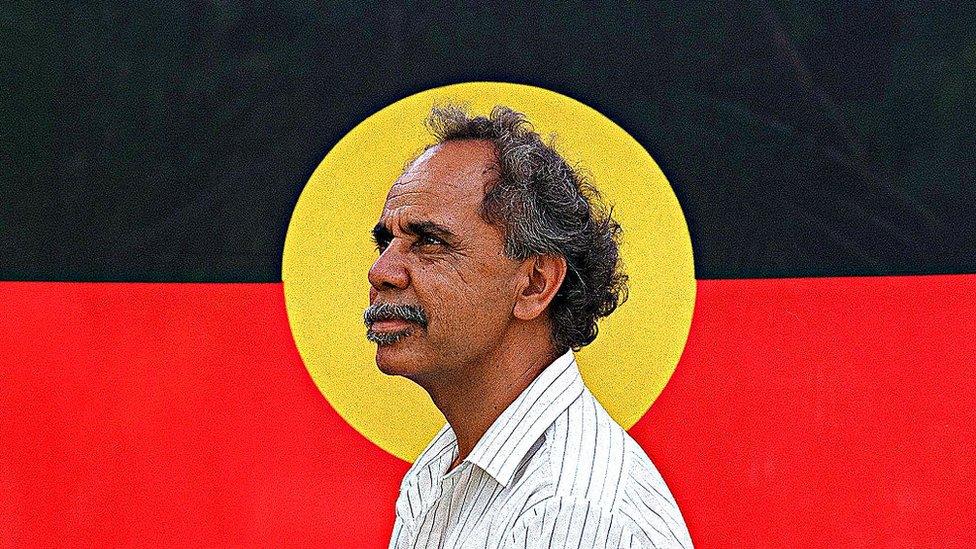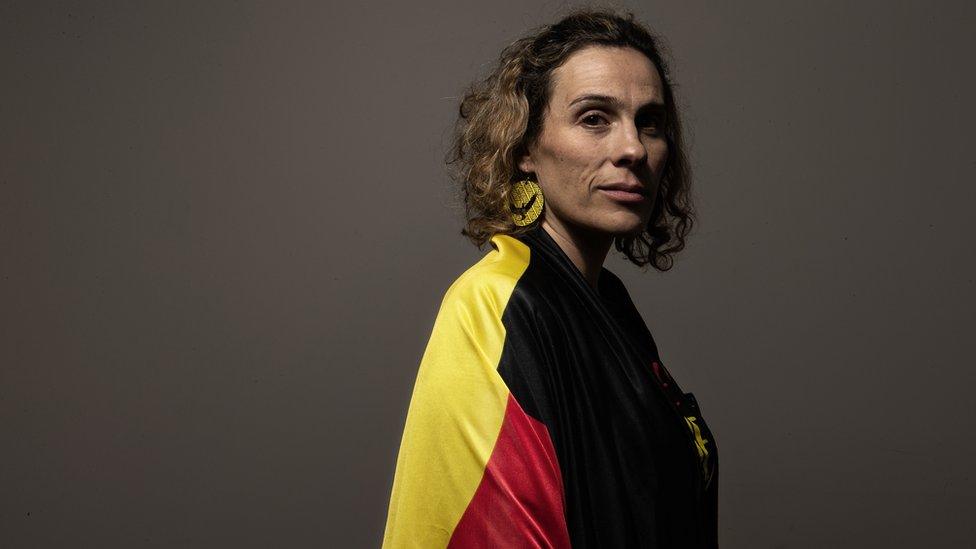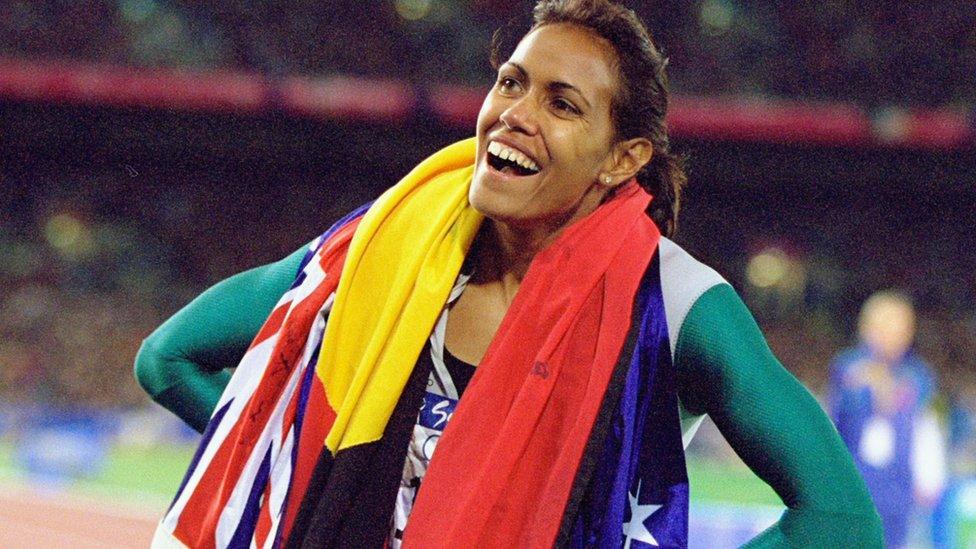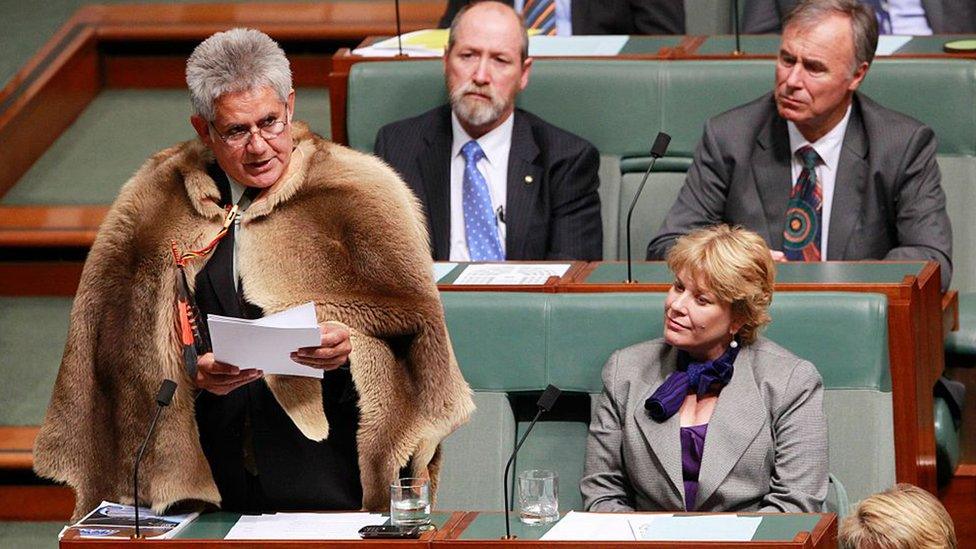The fight to 'free' the Aboriginal flag
- Published

The Aboriginal flag is a common sight around Australia
A black band to represent the people. Red for their connection to land. A yellow circle in the centre for the sun.
This is the design of the Aboriginal flag, which is seen all over Australia - atop bridges and buildings, painted on walls, printed on T-shirts.
Originally a protest flag, it's now recognised as the dominant symbol of Australia's Aboriginal people and is an official flag of the country.
So when it emerged last year that some Aboriginal people had been ordered to stop using it, many were confounded. Few people had known the flag was constrained by copyright laws.
Currently, even Aboriginal groups must pay a non-Aboriginal-run business to reproduce the flag on clothing and merchandise.
The situation has angered many people. Indigenous MP Linda Burney - who has the flag tattooed on her arm - has declared the symbol is being "held hostage".
Amid increasing pressure, Australia's government is now reported to be considering taking over the copyright, but it faces complex legal and cultural issues.
How did this happen?
Unlike most official flags, it is not owned by the government. Instead the flag belongs to Harold Thomas, an Aboriginal artist who designed it in 1971 for his people's civil rights movement.
Mr Thomas retains the full copyright - a status clarified by a legal battle in the 1990s - and he has leased reproduction rights to different companies over the years.
Most recently, in 2018, he signed a deal with a firm called WAM Clothing. It gives the company exclusive global rights to use the flag on clothing, physical media and digital media.

The flag's designer, Aboriginal artist Harold Thomas, in 1994
Unlike previous lease holders, the company has aggressively enforced these rights. Several Aboriginal organisations - including not-for-profits - have found this out the hard way.
"I got a cease-and-desist letter from some lawyers who told me that I had to stop selling the clothes within three days," said Gunditjmara woman Laura Thompson. She runs an enterprise which used to sell T-shirts with the flag on them, to raise money for an Aboriginal medical service.
Outraged by the legal threat, she started a campaign called Free the Flag. Her online petition has received close to 150,000 signatures - it was presented to parliament last year.
"How can one person or business have a monopoly over it? The flag belongs to all Aboriginal people. Why do they have to pay for it?" she told the BBC at the time.
"It's a symbol of our people's survival. Many of us don't identify with the Australian flag because for us it represents colonisation and invasion."

Laura Thompson has launched a fight to "free the flag"
She added: "We're the ones who elevated it and gave it the status it now has."
WAM Clothing has since offered Ms Thompson free use of the flag, but she refused, incensed by what she saw as a non-Aboriginal company seeking to profit from Aboriginal identity.
Community anger has also escalated over reports that one of WAM Clothing's owners was previously involved in a business which sold fake Aboriginal art.

You might also be interested in:

In the past year, several Aboriginal politicians and prominent figures have joined the copyright protest.
But, perhaps typical of sports-crazy Australia, the issue gained most attention when the Australian Football League (AFL) refused to continue paying for the flag last month. Other sports - such as Australian rugby - have followed suit.
The AFL said it wouldn't use the flag in its Indigenous round - themed games which celebrate Aboriginal contributions to the game - in support of the Free the Flag campaign. Previously, the flag had been painted on the field and featured on the players' jumpers.
All teams signed the pledge, and urged spectators to wear or wave the flag instead. Observers also noted, however, that it allowed the AFL - cash-strapped by the pandemic - to save some money.
But the Aboriginal flag has long featured in moments of national pride. Sprinter Cathy Freeman famously carried it as well as the Australian flag after winning gold in the 400m at the 2000 Sydney Olympics.

Olympic gold medallist Cathy Freeman with the Aboriginal and Australian flags
Earlier this week, the Senate approved an inquiry into the flag's licensing rights. Lawmakers also passed a motion saying commercial interests were restricting the flag's use and "putting profit before pride".
It called on the government to do "everything in its power to free the flag, and get it back so it can be used by the whole community; at the same time as respecting Mr Harold Thomas".
Complex discussion
But is this possible? Under Australia's copyright laws, experts say Mr Thomas and WAM Clothing are fully entitled to licence and reproduction fees.
In a statement last week, WAM Clothing's founders said they would not stop individuals from using the flag for personal reasons. But clothing used commercially or to promote an organisation would be treated differently, they said.
Mr Thomas has said he leased rights to the flag to receive royalties for his artwork, and to prevent knock-offs made overseas.
He declined to speak to the BBC, but told an Aboriginal radio station last year that he had endured much criticism over the issue.
"The first lie that has been told is that I sold the Aboriginal flag- that's an outright lie,", external he told CAAMA Radio. He described suggestions he had betrayed his own people as "slander".
Last year, a spokesman for Minister for Indigenous Australians Ken Wyatt told the BBC: "It is not the government's place to tell Mr Thomas who he should or should not do business with."
But local media has now reported the government may be open to purchasing the copyright from Mr Thomas.
Writing in The Australian newspaper, external on Friday, Mr Wyatt said pitting legal rights against community was a "delicate and sensitive matter".
But he added: "I commit to doing everything I can to bring about a resolution that respects not only the artist of the flag, but a resolution respects the rights, enterprise and opportunity of all Australians."
- Published10 July 2019
